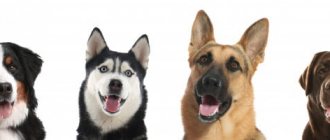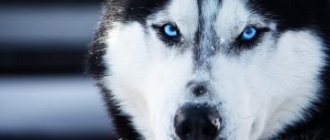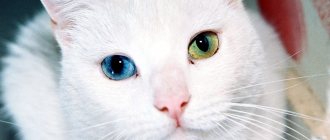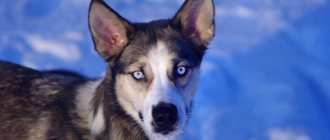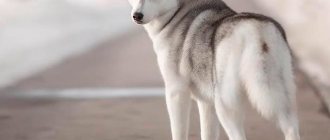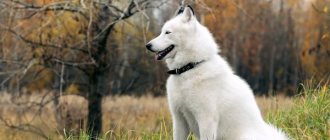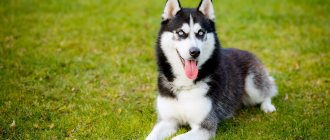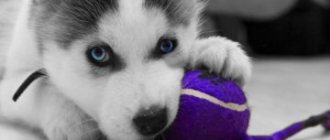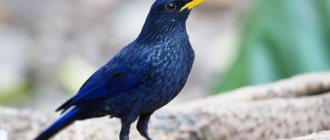Huskies are fast, strong and very beautiful dogs with a compact build, natural grace and friendliness.
They are usually very careful and attentive, but they have virtually no aggression.
But, despite this, this breed is suitable only for experienced owners, due to its character.
The height of an adult husky is 54-60 cm, weight – 18-28 kg, life expectancy – 12-15 years.
Origin story
The breed is believed to have originated over 4,000 years ago in Siberia . These were sled dogs bred by the nomadic tribes of the north, as they needed strong and hardy helpers.
Huskies were used not only as sled dogs, but also performed many other functions: they were hunting assistants, watchmen, and nannies for children.
The name "husky" was given in honor of the Eskimo or "Eski" people, who are believed to be the breeders of this breed..
Huskies were registered in 1934 in the USA, and the standard appeared at the same time. It is only thanks to the work and interest of American dog breeders that the breed has survived to this day and gained such popularity.
After all, it was huskies that provided invaluable service to American gold miners at the end of the 19th and beginning of the 20th centuries. Currently, this dog is most often used as a companion.
Some historical data
The Siberian Husky breed is one of the oldest, the genomic composition of which differs little from that of a wolf.
The first to tame and domesticate these dogs were the Chukchi.
People in Chukotka used these animals as riding, guard and shepherd animals. Long years of natural selection have produced a healthy, hardy dog breed.
Huskies were first introduced to the states in 1908. During the “gold rush” season, the team with huskies came third to the finish line. After this event, this breed began to be taken more seriously.
The most famous feat performed by this dog occurred in 1925, when the husky dog Balto, in harness with other brothers, along a difficult path of 1085 kilometers, delivered the long-awaited vaccine to the city in order to save the local people of Alaska.However, over time, the Siberian Husky lost primacy in the races to other breeds. Today the entire breed is divided into working, racing and show class representatives.
What color should your eyes be? What are these dogs called?
The most common iris color in the Husky breed is blue. Moreover, this color is not light blue, like a person’s, it is rich, bright, with a slight azure tint.
In the exterior of this breed, this color is the most sought after and popular.
However, previously such an appearance was considered a defect, since it was believed that the blue color of the iris indicates a visual impairment.
Later it turned out that this was not so and the blue eye color became the calling card of the breed.
However, there are other iris colors that are considered officially acceptable and comply with the standard, these are:
- Green.
- Amber.
- Gray.
- Brown.
- Black.
In addition, the breed standard allows heterochromicity . That is, a dog can have a different color of the iris, and still be considered a purebred and even take part in exhibitions. Such dogs are also called harlequins.
Photo
Further in the photo you can see white and other colored adult dogs and husky puppies with blue, brown and different eyes.
Standard or defect?
As already mentioned, different eyes in a husky are not a defect or a deviation . This phenomenon is absolutely normal. But, there is a nuance here: if the color of your pet’s iris has changed in the first year of life, then this is quite natural.
If the iris changes with age, then this may be a sign of a disease and requires contacting a veterinarian.
If we talk about purebred, a Husky dog can have eyes of different colors, the most common of which are:
- Blue.
- Brown.
- Amber.
- Green.
- Heterochromic.
All this is considered the norm and is recognized by international standards.
Heterochromic irises in huskies are a unique feature that gives the dog a special mystery and beauty. It happens that the color of one eye is blue and the other is brown.
This heterochromia is called complete . But, there are cases when one pet’s eye has an even tone, and the second includes various shades (dots, spots, etc.). This option is called sectoral heterochromia.
All these phenomena are provided for by the standard and in no way indicate that the dog is not purebred.
Husky character
Husky dogs themselves are affectionate and kind. They will show special love only to their owner, thereby showing their devotion and understanding that he is the unquestioning authority for them.
When buying a husky puppy, you need to understand that this dog is not created to protect your home and you, including.
These serious-looking dogs, with the severity of a wolf, have an affectionate cat-like character.
Huskies love the company of people, especially spending time with their owner, therefore, you should not leave the dog alone for a long time, as boredom may cause it to exhibit wolf genes, namely loud howling.
Friendly huskies make great friends for children and your guests.
Huskies easily endure the road and love to travel, therefore, huskies are an excellent partner for long walks, hikes and other active activities.
An even bigger advantage of owning a Husky is that they do not require any special care.
The dog takes care of its own hygiene, therefore, there is practically no unpleasant smell of fur. Frequent washing is contraindicated for huskies; 1-2 times a year is enough.
Do not forget that huskies, like all animals, have a molting period. This happens 2 times a year and manifests itself in profuse hair loss. During this period, it is necessary to comb the dog so that it has a neat appearance and creates less discomfort in terms of cleaning the room where the dog is kept.
Grooming is contraindicated for huskies, since their thick and smooth coat protects them from both cold and heat.
If the dog lives in an apartment and does not have the opportunity to grind down its claws naturally, then it is necessary to trim them regularly with special pliers. Otherwise, overgrown claws can create discomfort for the animal.
Huskies will not really like living in an apartment, as this breed needs to constantly move, so they need a lot of space. Also, when choosing a Husky as a member of your family, be prepared for long and daily walks, as this breed needs regular exercise.
Husky is a sled dog, therefore, it is not a problem for her to push children on a sled in a sled, or carry a load during a hike.
Raising a husky must begin from an early age, since if you miss this moment, you can lose control over it.
The dog will try to dominate, therefore, it needs to be regularly reminded of the authority of the owner.
You should not hit or show aggression towards the husky, as it may become offended and stop considering you its owner.
Reasons for appearance
The main reason is a hereditary deficiency or excess of a substance responsible for the color of fur , skin and irises . This substance is called melanin. It is its quantity that will determine not only the color, but also the intensity of the shade of the iris.
The second reason is crossing individuals with different eyes, for example, a blue-eyed dog and a brown-eyed dog.
Another reason is illness. Often, as an adult dog ages, one eye begins to take on a different shade and becomes cloudier or darker.
NOTE!
Almost all newborn husky puppies have a bluish iris and at first it is impossible to determine the future eye color.
Only in the 6th month of life does the iris begin to acquire a color that will remain with the pet for life.
When is coloring determined in puppies?
Almost all huskies are born with bright blue irises. Newborn puppies begin to open their eyes around the 20th day after birth, and the retina completes its formation on the 21st - 22nd day.
At about six months of age, the color of a husky's eyes begins to change and does not always remain blue. Therefore, when purchasing a puppy under the age of six months, you cannot be absolutely sure of the pet’s future color.
Husky eyes are the hallmark of this breed. By deciding to become the owner of a husky, you will get yourself a friend with soulful blue or deep brown eyes. Or maybe a real “harlequin” will settle in your house.
What color eyes are there?
Blue and brown
The most common combination of iris colors in heterochromic pets is blue and brown . Moreover, this combination is most often found in animals of black and white, gray or wolf colors.
It can be found much less frequently in pure white or black representatives of the breed.
Gray and blue
Less common are combinations such as gray and blue . The look of such a dog will seem especially piercing due to the fact that the pupil stands out brighter on the light iris, which gives the pet an unusual and mysterious look.
But there are also disadvantages to this combination. The gray and blue irises are particularly sensitive to light and this affects the dog's ability to adapt . An animal with such a cross-section of eyes constantly squints in the bright sun and therefore gets tired faster when walking.
Green and brown
Green and brown shades are a rather rare combination, but it also occurs sometimes . It is worth noting that puppies with such heterochromia can cost several times more than pets with a standard color combination (blue and brown).
Amber and brown
This combination, as a rule, is rare, but such pets are considered more hardy and resistant to stress.
In addition, the iris of amber and brown shades does not react so sharply to light, which does not cause additional fatigue in the dog.
What is the reason for the abundance of colors?
Siberian huskies were bred by the Chukchi tribes on the basis of aboriginal dogs - close relatives of wolves. They transported light loads over long distances.
They bred hardy pets that were not afraid of frost and easily tolerated hunger. The emphasis was on working qualities, and appearance was not given importance.
Today the working breed has been “retrained” as a companion. The trend has developed due to the spectacular appearance of dogs: a fluffy coat, a fox tail, erect ears and an expressive face.
Because of their working background, Huskies come in so many colors.
According to the Fédération Cynologique Internationale (FCI) standard No. 270, any color is allowed - from white to black, in any combination of colors, with or without various markings on the head.
Genetics are amazing: future coloring depends on one pigment - eumelanin. It gives the coat a black or brown color. And the combination of color-forming genes determines what color the puppy will be born.
Foreign breeders distinguish about 20 colors of Siberian Huskies. Domestic ones are more conservative and consider only white and its combinations with gray, brown and black to be correct.
But the rest of the husky colors are not a defect. Dogs of this breed are born as diverse as snowflakes.
Unlike colors, everything is clear with wool. The standard allows only straight hair of medium length, with a thick undercoat.
There are opinions that long-haired huskies are not breeds. But that's not true. Long, coarse, shaggy hair hides the dog’s silhouette, it is difficult to care for, mats, takes a long time to dry, and interferes with thermoregulation.
Brown eyes
Brown-eyed representatives of the Husky breed are quite common, and such dogs can often boast of good conformation.
Moreover, the color of the iris can have a variety of shades from yellowish-brown to dark with an amber tint, and some individuals have an almost black iris.
And this is also the norm and does not lead to a decrease in scores. At the same time, there is a pattern - the darker the dog’s fur, the darker its iris, and this applies specifically to brown-eyed individuals. But there are other cases.
Quite often, pets with light fur have brown, light brown or amber eyes . As a rule, such animals always have warm and reddish shades in their fur, as well as inclusions of white hair.
It is also often possible to find individuals with a pronounced red coloration and at the same time having a rather dark iris . Such animals often have dark brown spots of a warm shade.
All this suggests that there is a certain connection between the color of the coat and the iris of the eyes, laid down at the genetic level.
Common colors
No two huskies are alike: from birth, each puppy has its own coat pattern and color. But you can group the most common suits into separate types.
Black and white
With this type of color, the amount of white and black is approximately equal. The dark part of the coat is on top, the light part is located below. There may be areas with red spots on the back of the thighs.
Black and white color comes in 2 types:
- the hairs are fully pigmented, the shade of the undercoat is gray or black - such dogs look more expressive in person and in photos;
- the hairs are half pigmented, and the undercoat is white or gray.
Red and brown shades
Brown-white
It comes in different expressions - from rich dark to light cream colors. Depending on the concentration of pigment on the hairs, there are 2 subtypes of brown color:
- chocolate – darker and more pronounced;
- copper: lighter than chocolate, different shades - from bright to muted.
In the photo: on the left is a chocolate husky, on the right is a copper one
Red and white
It is also called red. Saturation depends on the pigment concentration. Dogs with bright fur appear fiery, while dogs with muted coats appear light red.
In the photo: fiery red shades (husky on the left, malamute on the right)
Because of this perception of colors, the red color is written as anything - from brown to fawn. This is not considered a mistake. In addition, during the first molt, puppies change color slightly. So don’t be surprised if the color of a pet with a light brown coat is designated as “red” in the passport.
Pale yellow
Close to red. However, it is not saturated, but muted tones - light brown, cream, golden.
Gray shades
Grey
The undercoat can be silver, gray, cream, fawn. And guard hair is found in 3 variations:
- black in combination with white - sometimes this color is considered black and white;
- only the ends of the hair are black;
- the ends of the hair are colored in a non-intense, as if muted black - giving the fur coat a bluish-silver tint.
The latter variation is often classified as a separate color type - silver. Although this is just a variation of the gray color of the husky.
Wolf
It is also called zonal, sometimes and mistakenly called gray. Most of the first representatives of the breed were wolf in color, but breeders relied on other colors, considering them more beautiful.
In the photo: wolf-colored husky. On the right - can also be classified as agouti.
The wolf color combines a beige undercoat with gray guard hair and splashes of brown. Tan marks are most often located on the back of the head, neck, ears, and limbs.
Green eyes
The green color of the eyes of a husky has the ability to refract sunlight in a special way, due to which it looks deeper, brighter and more saturated.
Such pets are quite common in dog breeding . But most novice owners are wondering - do these dogs really have green eyes? The answer is no.
Green shades of the iris are a derivative of the amber color, which means that visually it can appear green, but only from a different viewing angle. Therefore, you will never be able to find a husky with bright green eyes.
Green eyes are most often found in pets with warm coat tones, ranging from fawn to dark brown..
Advantages and disadvantages
Pros:
- Brown Huskies are smart and quick-witted.
- These are dogs that can correctly assess the situation and make decisions independently if necessary.
- They look beautiful and impressive, especially if they have brownish-copper colored fur and blue eyes.
- There is no aggression towards people.
- They treat children well: they willingly look after the kids and become excellent companions for them when they grow up.
- They adore their owners and are ready to follow them everywhere.
- They are easy to care for.
- Suitable for both home and apartment use.
- Hardy and quite unpretentious in maintenance and feeding.
Minuses:
- Brown huskies tend to be stubborn at times.
- They love to dig up the earth and are not averse to undermining.
- Predisposed to escape and wandering.
- Out of boredom, they can begin to damage furniture or other things in the house.
- They love to howl like wild predators.
- If not socialized, they can be dangerous to smaller pets.
- Not suitable as a hunting or guard dog.
- They are very mobile and need a lot of physical activity and long walks.
Blue eyes
The most common representatives of the breed are those with blue eyes . These are the types of pets that can most often be found on the street and these are the kind of puppies that can be purchased from most breeders.
As a rule, dogs with gray, white and black and white coat colors have blue eyes. According to dog handlers, animals with such irises are more vulnerable, friendly and more strongly attached to their owner.
They are more flexible and easier to train.
At the same time, such pets need care and attention more than others..
But, there are cases when a completely black individual has blue eyes. This phenomenon is considered very rare and even unique. As a rule, dogs with an unusual combination of color, coat and iris receive the highest points in shows.
Features of the suit
The appearance of dogs of this color is, first of all, a light, aristocratic appearance. The dogs are active and love an active lifestyle and walks in the fresh air. They easily find a common language with other animals and are able to act together, for example, in a common team.
Males are rightfully considered stronger and more resilient. They are larger in size and have a more powerful backbone. Females, on the contrary, are more graceful and fragile, but female representatives of this color cannot be called weak.
Huskies are medium-sized animals with very thick hair and a dense undercoat. They have straight ears, and their tail is more like a huge feather. Dogs of average build, and with proper care and feeding regimen, do not suffer from excess weight. But all this is not the main thing when it comes to huskies. After all, the whole world fell in love with dogs not for their size, coat color or feather-like tail. A husky's pupils are a pet's real asset. They fascinate, impress, and sometimes their gaze sends a chill through your skin.
Grey eyes
Gray eyes in huskies are not uncommon and are most often found in dogs with light coats.
Most experts agree that the gray color of the iris is nothing more than a lighter shade of blue, which appeared as a result of a special mutation in the genome, due to which the eye color acquired an icy-gray tint.
There is such a variety of huskies as albinos, which have light gray eyes with a cold tint, but such individuals are extremely rare.
Age-related changes
As you can imagine, it is quite rare to find a dog that does not truly meet the Husky standards in some way. Eyes of many variations and shades are considered completely normal. Moreover, they can change with age.
Purebred huskies not only have fairly bright irises, but are also subject to changes throughout their lives. Thus, a puppy is most often born with a blue tint, or, as we have already figured out, azure. Later, as the individual grows up, the eyes acquire completely different tones, sometimes even completely different from the original ones. There is no need to worry about this, except in certain cases:
- if the dog initially did not have the heterochromia gene, and suddenly its eyes become different, there may be a health problem due to taking some medications;
- It happens that a mature husky of adult age also begins to experience a sharp change in the color of the iris, which means that there are some serious changes in the body, and it is also better to play it safe by going to a specialist.
Does eye color change over time?
The answer to this question is yes. Over time, the color of a Husky's iris can change, a phenomenon called acquired heterochromia.
The causes of this phenomenon may be eye diseases or long-term use of powerful drugs . Usually acquired heterochromia is an alarming sign and requires contacting a veterinarian.
Huskies can truly be called an amazing breed of dog. On the one hand, they look like wolves and have a stern appearance, on the other hand, they have a soft and good-natured character.
And if such a dog also has eyes of different colors, then this is a unique sight.
As breeders say, if a husky harlequin appears in the house, then happiness will never leave it..
Care
Caring for such representatives is no different:
- Treatment of eyes from excess secretion 2 times a week, using a specialized lotion for dogs, it can be purchased at any veterinary store. Or by independently preparing a decoction of herbs with an antiseptic effect (chamomile).
- The decoction should not be hot or too cold; you will need to moisten a cotton pad or haze cloth in it, and then wipe your eyes: from the inner edge to the outer, removing accumulated secretions.
